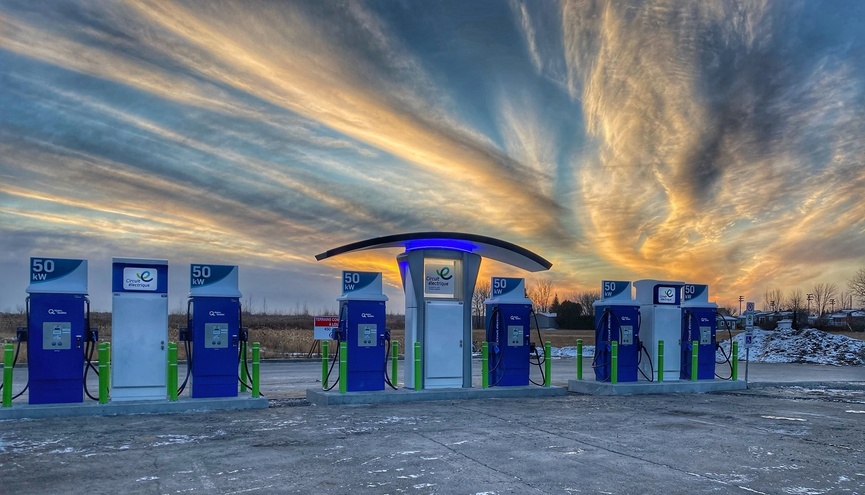OTTAWA – The Canadian auto industry has warned the country’s provincial governments against adopting ambitious sales mandates for electrified vehicles when the federal government is rolling out its own requirements.
Canada’s Liberal federal government is developing detailed legislation setting a deadline for sales of all new light-duty vehicles to be zero-emission vehicles (ZEVs) by 2035 and medium- and heavy-duty vehicles to be ZEVs by 2040. Proposed regulations may come as soon as the New Year.
Meanwhile, the Canadian provinces of Québec and British Columbia have been pushing ahead with their own contrasting ZEV sales mandates for their respective markets of 8.5 million and 5 million (Canada’s total population is 38 million). https://tc.canada.ca/en/road-transportation/innovative-technologies/zero-emission-vehicles/canada-s-zero-emission-vehicle-zev-sales-targets
The “Zero-Emission Vehicle Sales Standard” (ZEV Standard) developed by majority French-speaking Québec is designed to push automakers to introduce electrified vehicles in that province faster than elsewhere in Canada. That standard commits each automaker selling in Québec to earn credits linked to ZEVs’ proportion of their vehicle sales, to ensure all new autos sold in the province are zero-emission by 2035. While that deadline matches the goal of the federal government, Québec’s standard pushes automakers to sell more ZEVs in the interim years.

The Québec government is toughening this standard, having completed public consultation on detailed plans in July. This plan makes earning ZEV credits tougher, for instance by reducing the credits manufacturers can claim for past electrified-vehicle sales, or for reconditioning vehicles to reduce emissions.
“The essence of these proposed changes to Quebec’s mandated zero-emission-vehicle targets is to drastically increase the stringency of the regulation less than six months after their previous consultation,” says David Adams, president of the Global Automakers of Canada industry alliance.
“Governments in Québec and across Canada need to be aware of the unintended consequences for consumers of setting targets that are both too aggressive and too costly for manufacturers to comply with,” he says. “These consequences can include increased vehicle prices and decreased model selection, both of which can result in older vehicles staying on the road longer – which does nothing to reduce greenhouse gas emissions.”
Adams says the Québec government needs to consider how inflation (6.9% in Canada in September) and rising Bank of Canada interest rates (probably 3.25% by December) will depress ZEV demand. This comes as the Québec government has been cutting consumer subsidies for new ZEVs to C$7,000 ($5,120) from C$8,000 ($5,830) and, for used ZEVs, to C$3,500 ($2,500) from C$4,000 ($2,915).
“This is not a recipe for success,” says Adams.
 In British Columbia, the government also has released plans to toughen its ZEV sales mandate, so that 90% of all light vehicles sold in the province by 2030 would be zero emissions. This would come via amendments to the province’s 2019 Zero Emissions Vehicles Act.
In British Columbia, the government also has released plans to toughen its ZEV sales mandate, so that 90% of all light vehicles sold in the province by 2030 would be zero emissions. This would come via amendments to the province’s 2019 Zero Emissions Vehicles Act.
Such a combination with federal EV rules presents a headache for manufacturers and dealers, Adams says: “They are all complicated and they are not all the same, and that’s a real challenge for the industry,” he says, noting provincial mandates are “more stringent and they (provincial governments) are not inclined to...let the national mandates prevail.”
Indeed, Canada’s current planned federal mandate for new ZEV sales is 60% by 2030. “The Québec mandate looks like it will be close to 65% to 68% by 2030,” Adams says.
Given manufacturers may have a limited number of ZEVs to sell in Canada, provincial mandates may impede the federal government from fulfilling a goal to make ZEVs equally available nationwide.
Manufacturers worried about paying stiff provincial penalties – which Adams predicts for the revised Québec and British Columbia rules will be C$20,000 ($14,580) for every internal-combustion-engine (ICE) car sold over a set ZEV/ICE ratio – may simply sell fewer vehicles of any kind in a province to stay within regulatory controls.
Other Canadian provinces also are offering contrasting incentives to consumers to buy EVs, even if they lack provincial sales mandates. In Nova Scotia, the government has been offering C$3,000 ($2,190) subsidies to electrified-vehicle purchasers, for instance. In Prince Edward Island, Canada’s smallest province, the government offers a ZEV purchase subsidy of C$5,000 ($3,650). These are combined with the current federal subsidies of up to C$5,000.https://tc.canada.ca/en/road-transportation/innovative-technologies/zero-emission-vehicles/light-duty-zero-emission-vehicles/incentives-purchasing-zero-emission-vehicles
While subsidies help, regulatory complexity does not, says Brian Kingston, president of the Canadian Vehicle Manufacturers’ Assn. He tells Wards: “There’s no need for this type of mandate. When the industry is complying with federal emissions standards as they become more stringent, the last thing we need is every province going ahead with their own tailor-made plan. It’s not going to be effective.
“From a business climate perspective, you have interprovincial trade barriers already and we are regulating really small markets with different standards and rules. It’s not a good way to be competitive for investment and not an efficient way to build EV adoption.”
As well as ditching the provincial mandates, Kingston (pictured, below left) says the Canadian government should wait before issuing its own mandate regulation until there is more clarity over the federal approach in the U.S.
 Noting how the Biden Admin. has taken a different approach by tightening tailpipe emission rules to encourage ZEV sales, he says Canada should mesh its approach with that in the U.S., including increasing sales subsidies to the American federal rate (now a possible $7,500 tax rebate under the Inflation Reduction Act.)
Noting how the Biden Admin. has taken a different approach by tightening tailpipe emission rules to encourage ZEV sales, he says Canada should mesh its approach with that in the U.S., including increasing sales subsidies to the American federal rate (now a possible $7,500 tax rebate under the Inflation Reduction Act.)
The same applies to charging infrastructure investment. Where the U.S. law earmarks $7.5 billion for a national charging network, the Canadian federal program sets aside C$680 million ($496 million). Given the close integration of the Canadian and American auto-making sectors and supply chains, an effective rollout of electrified vehicles will need complementary market incentives, Kingston says.
“The markets are only going to be aligned by similar consumer subsidies and investment in infrastructure for recharging,” he says.





